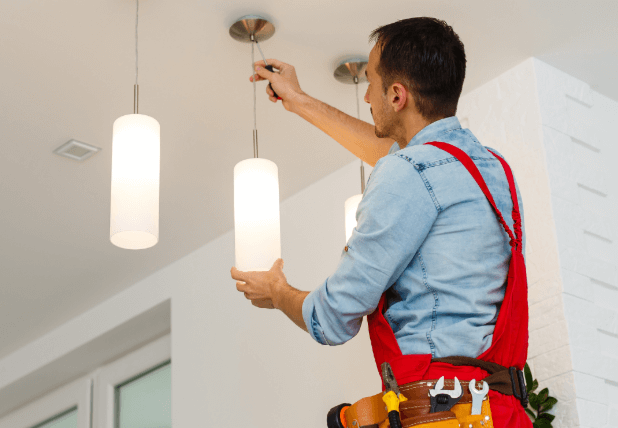Common electrical issues can manifest in various ways. Flickering lights, frequent circuit breaker trips, and burnt outlets are just a few signs. Understanding these signs can help you address problems early.
This guide provides a step-by-step approach to troubleshooting residential electrical circuits safely. It also highlights the importance of tools like the multimeter in the process.
However, not all electrical issues can be solved with DIY methods. Some require the expertise of professional electrical repair services. Recognizing when to call a professional is crucial.
We’ll also share electrical safety tips for homeowners. These tips will ensure you handle electrical issues without risking your safety.
Join us as we delve into the world of residential electrical troubleshooting.
Recognizing the Signs of Electrical Issues
Identifying electrical problems early can prevent bigger issues. Common signs include flickering lights, which may indicate loose connections.
Frequent circuit breaker trips suggest overloaded circuits. This requires immediate attention to prevent potential hazards.
If you notice burnt outlets, it’s a red flag. This could be a sign of overheated wiring that poses a fire risk.
Buzzing sounds from outlets or switches indicate possible wiring faults. Address these issues promptly for safety.
Finally, odd smells like burning can signal overheating. Unusual odors should never be ignored, as they might precede a larger problem.
Safety First: Precautions Before Troubleshooting

Before dealing with electrical problems, prioritize safety. Power off circuits before touching any components to prevent electric shock.
Use insulated tools to protect yourself from unexpected surges. These tools reduce the risk of accidental contact with live wires.
Keep water away from electrical fixes. Wet areas increase the chance of shocks, making troubleshooting dangerous.
Inform family members about troubleshooting. This prevents them from accidentally turning circuits back on while you work.
Always have safety gear on hand, such as gloves and goggles. This gear minimizes injury risk during electrical repairs.
Important Safety Precautions:
- Turn off the main power switch.
- Use insulated tools for all fixes.
- Ensure your work area is dry.
- Communicate with everyone in the house.
- Wear gloves and goggles during repairs.
Step-by-Step Troubleshooting Guide
Start troubleshooting by understanding the issue. Gather information about the problem from anyone in the house. Notice what specific appliances or rooms have issues.
Check your circuit breaker box. A tripped breaker is often the culprit for outages. Inspect each breaker to ensure none are in the “off” position.
If you’re uncertain about a specific breaker, gently flip each one to confirm its state. Proceed with caution to avoid surprises.
Consider all possible sources of the issue such as frayed wires, old connections, or overloaded circuits. Look for visible signs of wear.
Use a multimeter to test voltage levels. Multimeters help pinpoint where power cuts occur and verify if outlets supply power.
After identifying potential issues, address them promptly. Tighten loose connections or replace parts that show damage.
Keep track of the solutions you try. Documenting your steps helps if you need to retrace them or call for help later.
Test your fix after every step to ensure you’ve solved the problem before moving to the next one.
Stay patient and methodical. Rushed fixes can lead to further complications or hazards.
Don’t hesitate to stop if you’re unsure. Electrical repairs can be complex and sometimes require professional assistance.
Tripped Circuit Breakers and Blown Fuses
Tripped circuit breakers and blown fuses are common electrical issues. First, locate your home’s breaker box or fuse panel and determine which circuit breaker tripped or fuse blew.
Circuit breakers trip due to overloads or short circuits. Identifying the cause is crucial to prevent repeat issues. Once located, reset the tripped breaker by turning it off, and then back on.
In the case of a fuse, replace the blown fuse with one that has the same rating. Ensure no excessive power demand continues in the circuit.
If these issues persist, it may be time to consult an electrical contractor. Persistent problems could signal deeper issues within the electrical system.
Faulty Outlets and Switches

Start by testing faulty outlets using a voltage tester. This tool helps check whether the outlet is live.
If the outlet has no power, inspect the wiring connections. Loose connections can interrupt the electrical flow.
For faulty switches, ensure they are turned off. Then, unscrew the switch plate and check for burned or loose wires.
Replace damaged switches and outlets with new, properly rated ones and secure connections to ensure safe and reliable operation.
Call a professional electric repair company if problems persist beyond loose wires or surface issues.
Flickering or Dimming Lights
Flickering or dimming lights often indicate loose connections. Check for loose bulbs and secure them in sockets.
Examine the light fixture wiring. Loose or improperly connected wires can cause flickering.
Consider the bulb type. Incompatible dimmer switches can cause lights to dim erratically. Verify the bulb-dimmer compatibility.
If fixtures continue flickering, check the circuit for overload. Excessive load can cause lights to behave erratically.
Persistent dimming might require help from electrical repair services. Expert evaluation can identify any wiring or load issues.
GFCI Outlets: Testing and Resetting
Ground Fault Circuit Interrupters (GFCIs) prevent electrical shocks. Press the “test” button on the GFCI to simulate a fault. The outlet should cut power.
If the outlet doesn’t cut power, it may need replacing. To reset, press the “reset” button and check if power is restored.
Test GFCIs monthly to ensure they’re working correctly and maintaining safety.
If a GFCI repeatedly trips, inspect connected appliances. Faulty devices can trigger GFCIs due to underlying electrical faults.
A licensed electrical contractor can diagnose persistent GFCI issues. Experts ensure outlets meet safety standards and perform as needed.
When to Call a Professional Electric Repair Company

Knowing when to call a professional is crucial for safety. Some electrical issues are too complex for DIY fixes. Recognize situations where expert intervention is needed.
Consistent circuit breaker trips suggest larger issues. If this happens repeatedly, consult a professional. They can uncover problems not visible to the untrained eye.
Repeated flickering or dimming of lights indicates a deeper issue. A licensed electrician can diagnose and correct the cause. Ignoring these signs might lead to serious hazards.
Burning smells or discolored outlets require immediate attention. These are signs of potential electrical fires. It’s essential to contact an electric repair company quickly.
Aluminum wiring and outdated electrical panels pose risks. Upgrading these systems should be handled by qualified electricians. They ensure installations meet all safety regulations and standards.
Electrical Safety Tips for Homeowners
Safety should always be a top priority in your home. Following basic electrical safety tips can prevent accidents.
Safety tips include:
- Turn off power at the main panel before repairs.
- Use the correct wattage for light bulbs.
- Never overload an outlet or extension cord.
- Keep appliances dry and away from water.
- Test GFCI outlets monthly for proper function.
Regular inspections can avert potential hazards. Check for frayed cords and worn outlets.
Maintain a tidy electrical panel. Proper labeling aids in faster troubleshooting.
Ensure smoke and carbon monoxide detectors function properly. These can save lives in an emergency.
Teach children electrical safety basics. Young ones should understand the danger of sockets and cords.
Maintaining Electrical Health in Your Home
Keeping your home’s electrical system in top shape is crucial. Regular maintenance and prompt repairs can prevent serious issues.
Always prioritize safety and call professionals for complex problems. A well-maintained system ensures peace of mind and safety for your household.
Contact Rocky Hill Electric today for expert residential electrical services in San Rafael!
